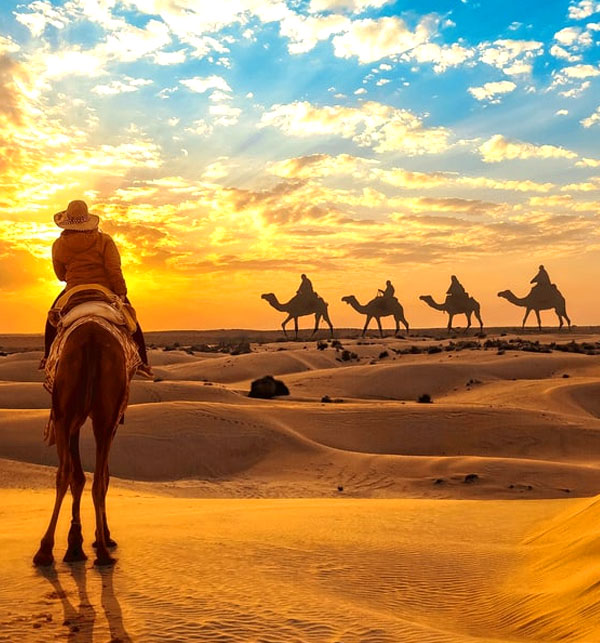
The golden city of Jaisalmer sits majestically in the far west of Rajasthan; its fort soars above the dusty Thar desert and its walls envelop a labrynth of twisting narrow streets, still inhabited today. It’s a magnificant place, and there are few cities in India that evoke such mystery and intrigue. Sadly Jaisalmer’s hawkers have an unfavorable repuation these days and this can become a little tiring while walking through the forts steamy and narrow streets.. For many a camel safari out into the dunes is what makes this place, providing an impossibly romantic and incomparable experience. We think it’s well worth a visit if a desert adventure is what you are after.
Distances| Jodhpur to Jaisalmer distance | 291 km. |
| Jaisalmer to Kheechan distance | 175 km. |
| Jaisalmer to Rohetgarh distance | 341 km. |
| Jaisalmer to Osian Temple distance | 241 km. |
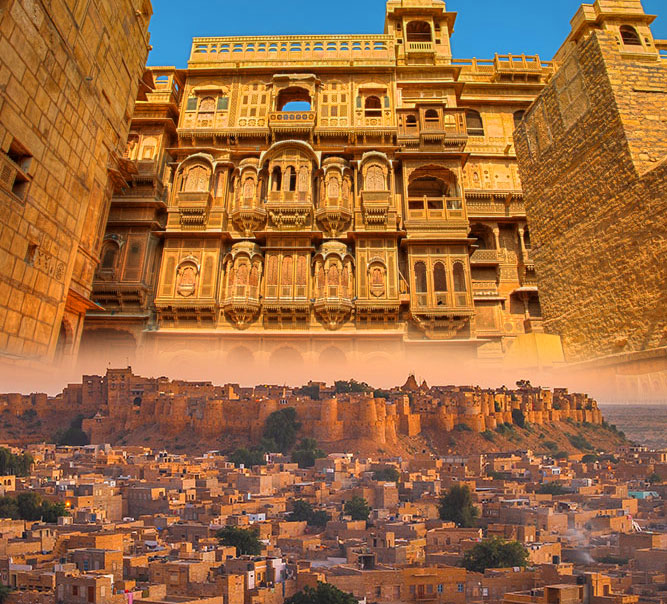
Built by the Rajput ruler Rawal Jaisal in 1156 AD this UNESCO World Heritage site is the pride of the Thar desert and is a symbol of strength, the fort is on a hilltop site that legend says he chose on the advice of a wise local hermit.
The quintessential desert town of Jaisalmer sits in the westernmost corner of Rajasthan and at its heart is Jaisalmer Fort, a gargantuan sandcastle that soars from the sandy plains below. Despite being fairly commercialised, most of the town still live within its ninety-nine bastions and ramparts that encircle its twisting lanes. Most of the inhabitants are Brahmins and Rajputs, some living in ancient havelis that were once the ornate homes of wealthy traders. At the centre of the fort lies the main chowk (square) and the Palace of Maharawal, open to the public as the Fort Palace Museum. The fort is also home to a number of temples, including the venerable Laxminath Temple of 1494, as well as a collection of interconnected Jain temples. Our half-day tour explores the intricacies of this historic desert fort and aims to avoid the more commercial and touristy areas.
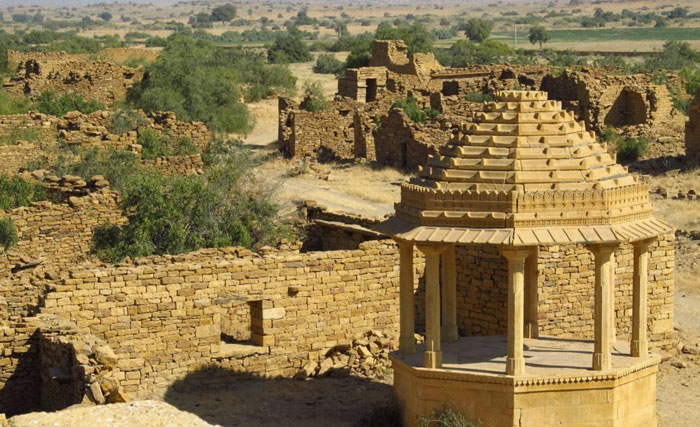
Visit Kuldhara, the stone remains of a city built in 1291. Kuldhara was the biggest of 84 villages built by the Pallwal Brahmins of Jaisalmer. During your tour you will learn about their industrious nature, their progressive sense of geometry and unique urban planning. Approximately 150 years ago the inhabitants packed up and left Kuldhara overnight, leaving only the village temple. They were never to be seen again. Your guide will explain the myths and legends associated with the disappearance of the residents and why some believe Kuldhara is cursed and haunted to this day.
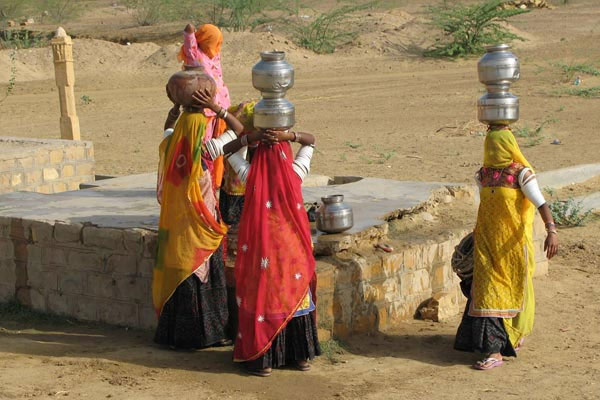
Surrounded by golden sand dunes, the tiny village of Khuri sits approximately 45 km from Jaisalmer. We think Khuri is well worth a visit as it’s an excellent example of desert architecture with huts built out of thick mud, to protect families from the extreme desert climate and harsh winds. The exteriors, interior walls and floors of the huts are often adorned with striking and unique folk art. After visiting some of the traditional huts you will enjoy a short camel safari (45 minutes – 1hr) on the golden dunes or a desert jeep safari by 4x4 jeep, just before sunset.
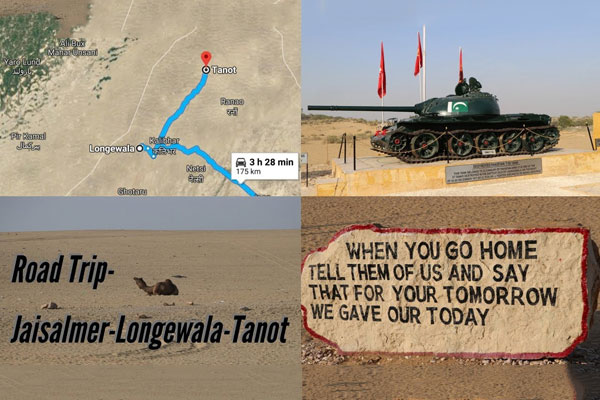
| Jaisalmer to Tanot mata temple distance | 121 km. |
| Tanot mata temple to Longewala battlefield | 45 km. |
| Jaisalmer to Longewala distance | 125 km. |
from Jaisalmer to Tanot Mata, Longewala and further to the international border. This part of thar desert is not a typical tourist destination, not even known by many tourists. It is a true offbeat destination to cherish a lifetime memory.
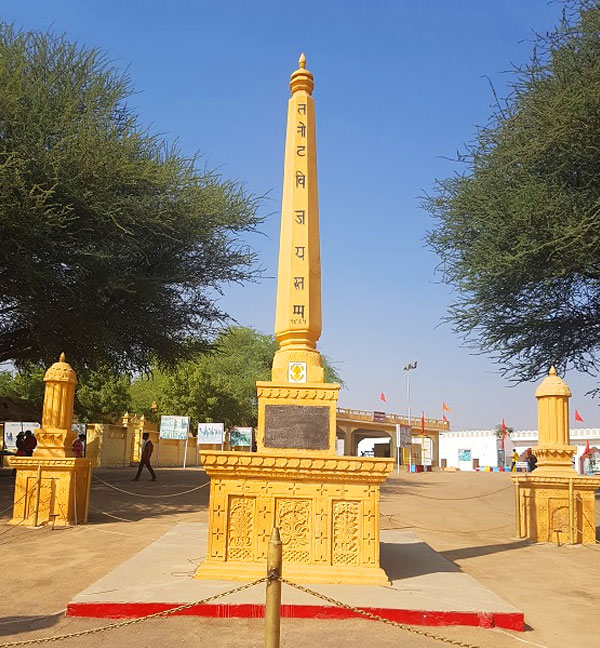
Situated 120km North West of Jaisalmer Tanot Rai Mata Temple is an old temple with a history of India Pakistan war of 1965. Hundreds of shells fallen here did not harm the temple. Some bombs are in display at temple. Maintained & managed by BSF( Border Security Force) of India.
Locals always had a great respect for Tanot Mata, who is considered as the incarnation of Goddess Hinglaj. Original Shaktipeeth of Goddess Hinglaj is situated in the Baluchistan province of Pakistan. This small temple was not famous outside the local community until 1965. During the India-Pakistan War of 1965, army personnel observed the miracles of Mata Tanot and then, this temple became a centre of special reverence for armed forces.
In 1965, during the war, Pakistani army captured Kishangarh and Sadewala and attacked Tanot from three sides. Tanot was a strategic point to move towards Jaisalmer. They fired at least three thousands bomb shells, at least 450 shells were fired on the temple. All of 450 shells neither hit their targets nor exploded. In the middle of that war zone, the temple stood tall without any damage. Assuming that Mata Tanot is with them, Indian soldiers fought bravely and forced the enemies to flee from their territory.
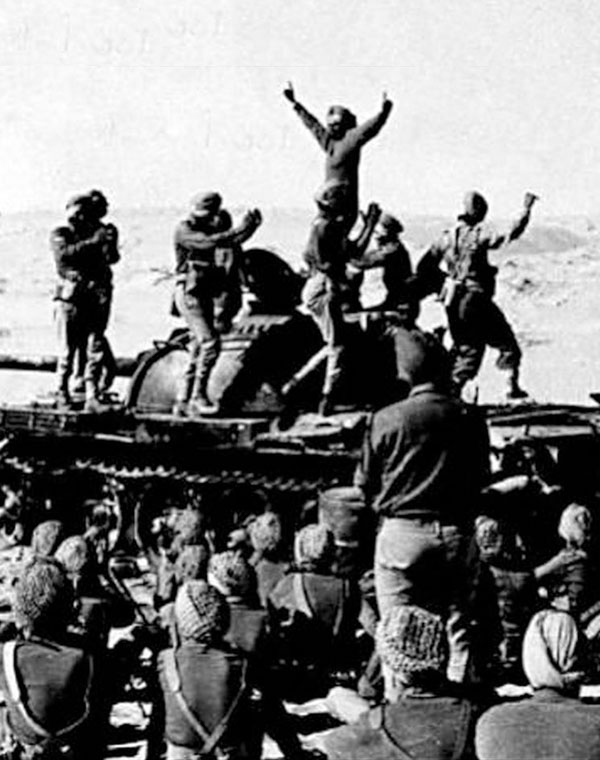
At Longewala the BSF bunkers are the only human settlements there. It was the famous battleground of 1971 war that became a graveyard of Pakistani Tanks, other vehicles and supported machineries. At least 37 Pakistani tanks and 138 vehicles/machinery were destroyed or abandoned in the battle. A T-59 tank, hit by an Indian RCL gun at the same spot, is still there on display with some other vehicles lying around in the sand.
Situated further afield 18km from Osian on the way to Kheechan, Ramdevra and Jaisalmer at the edge of Thar desert, on a relatively high sandy hill and beside a community nature reserve, serene escape from the 'hustle and bustle' of the busy Indian cities and away from crowds of touristic resorts. Occupying only 05 huts (Jhumpas) including one purposely built cottage for family stay, each of the 05 rustic huts has been individually decorated with local earth colour painting on outer walls and with local textiles indoor. The bed rooms showcase comfortable twin bed with floor is awash with locally woven camel hair+ cotton carpet and fine filigrees in local designs; all are furnished with the owners’ traditional collection of rustic experience with little comfort. Each pair of Jhumpas (huts) has its private terrace to sit out in open to get pleasant sunlight in winter days and enjoy sky full of stars! at night some nature lovers and travellers who practice daily Yoga found this place a perfect rustic retreat in desert.
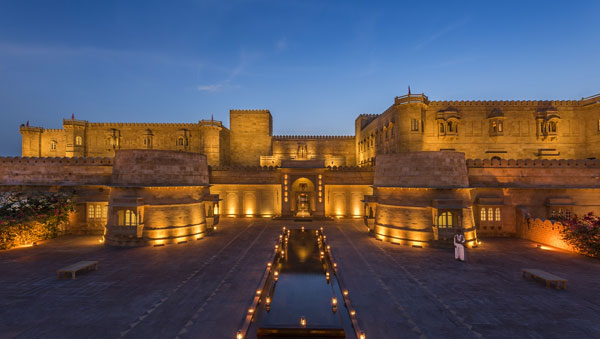
Suryagarh is modern palace that has been designed in the style of an 18th century fort. It sits just 20 minutes drive from Jaisalmer and features elegant courtyards and grand Rajasthani architecture. There’s an indoor pool, a spa and several restaurants to dine in. One of the hotel’s specialties is destination dining; guests can enjoy a picnic in a desert oasis, sun-downers on the dunes, and even breakfast with peacocks! Rooms are spacious, tasteful and very comfortable with crisp sheets, and en suite bathrooms.
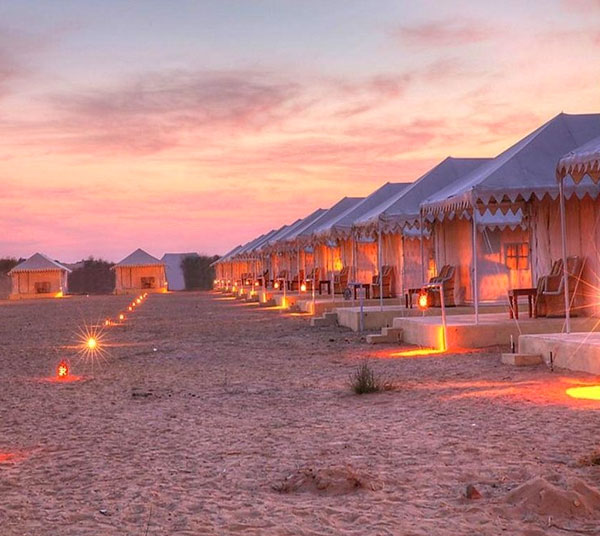
Indian deserts aren’t rows of dunes as far as your eye can see. In Jaisalmer’s Thar Desert, you’ll find pockets of herbaceous scrub, gnarly gum arabic trees and grasslands that shiver with the occasional quail or Chinkaras. For me, the best way to experience this environment is to stay in it. You could opt for somewhere like Khuri desert, 40km drive from Jaisalmer, a camel safari and camping destination that basically qualifies for tented camp resort as well as “open sky” sleeping under the stars!.
Or, for something more akin to past Silk-Route caravans, you can stay at Manvar Desert Camp. A line of white canvas tents arc around a central campfire, each with a running-water bathroom and traditional teak furniture (mimicking the wares that used to be hauled along on the back of camels). From here, I visited some of the nearby desert communities, including the Bishnoi. A religious Hindu sect, their belief in not killing animals is so strict that they check all firewood for insects before burning it.

Hans Overeem & Yvette Seppenwoolde, Netherland

Thank you so much for making our stay so interesting and enjoyable. you made a fantastic birthday party for Sarah. We will never forget sitting around the fire under the stars listening to the enchanting music of Rajasthan.
John & Sarah, Bristol, England

We enjoyed every moment of all the time we spent with you and your family. This was the real Rajasthan that we Marwaris had wanted to see for a very long time. The warmth and APNAPAN you showed us by having us as a guest in your house, was really special to us and we would cherish these moments and memories for all our lives. Thanks from the bottom of our hearts.
Divya & Chanchal Agarwal, Banglore, India





Thank you for all the kindness, good food and a lot of stories that give more insight and understanding of life and history in India. We love the quietness and peace if the desert an unforgettable experience.